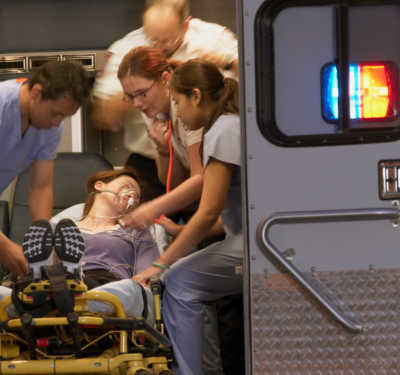The difficulty of looking for the obvious
Current models for predicting traumatic haemorrhage are not accurate enough to aid clinicians treating patients.
Published online 30 July 2016

Emergency medics need more accurate ways to diagnose haemorrhage following trauma.
© ERproductions Ltd/ Blend Images/ Getty Images
Haemorrhage accounts for 40% of deaths following injury1, yet diagnosing it can be difficult and largely subjective.
“Bleeding injuries are common, but detecting whether there is internal bleeding is difficult because patients compensate well for blood loss and may therefore not show clinical signs until late,” explains Alexander Olaussen of Australia’s Monash University department of community emergency health and paramedic practice.
Olaussen and colleagues reviewed literature on the topic from 1990 to 2015 and found that 36 different models have been developed to diagnose critical bleeding after trauma. Together, these models used 36 unique variables to predict the presence of haemorrhage.
“We have demonstrated that there is significant interest and need for early identification of bleeding after trauma. However, the attempts that have been done to date have not provided us with adequately accurate prediction scores,” says Olaussen.
Systolic blood pressure, the top number seen in a blood pressure measurement indicating the amount of pressure in the arteries when the heart contracts, was the most commonly included variable in these models. It is most often combined with heart rate in order to determine the shock index, used to identify patients potentially in shock.
But normal blood pressure values vary from one person to another. Having access to a patient’s records is thus important for a proper comparative assessment. Low blood pressure is also a late marker of shock and may be present in certain groups, such as injured children, without loss of blood volume.
Pathology results were another common variable used in the models; the two most requested being haemoglobin levels and base deficit — a measure indicating a lack of adequate oxygen delivery to tissues. In-hospital pathology tests were considered in some of the models, but technological advances now allow first-responders to assess some values on-site, which could be more appropriate for inclusion in prediction models, write the researchers in their review published in the Journal of Emergency Medicine, Trauma & Acute Care2.
The most commonly used form of imaging in the models was bedside ultrasound to screen for bleeding around the heart and abdominal organs. Imaging, however, is only useful if performed early, caution the researchers. Other forms of imaging, such as computed tomography, showed poor levels of sensitivity for the detection of internal haemorrhage in torso trauma and also take a long time to perform.
“Clinicians should remain highly vigilant about the possibility of bleeding after trauma. There is no validated combination of vital signs, blood results or imaging that can accurately exclude haemorrhage,” says Olaussen. “The clinician needs to take all of those variables into account. The shock index — defined as heart rate over systolic blood pressure — is easy to calculate, can be repeated at several intervals, and is an example of one scoring system that is easy to use.”
Olaussen believes the next step is a more dynamic monitoring approach that uses wireless monitors to transmit vital sign data in real-time from the scene to emergency specialists.
References
- Geeraedts, L. M. Jr, Kaasjager, H. A., van Vugt, A. B. & Frölke, J. P. Exsanguination in trauma: a review of diagnostics and treatment options. Injury 40, 11–20 (2009). | article
- Olaussen, A., Thaveenthiran, P. Fitzgerald, M. C., Jennings, P. A., Hocking, J. et al. Prediction of critical haemorrhage following trauma: A narrative review. Journal of Emergency Medicine Trauma & Acute Care (2016). | article
DOI: 10.1038/qsh.2016.122

